Jinhao Li
MMReID-Bench: Unleashing the Power of MLLMs for Effective and Versatile Person Re-identification
Aug 09, 2025Abstract:Person re-identification (ReID) aims to retrieve the images of an interested person in the gallery images, with wide applications in medical rehabilitation, abnormal behavior detection, and public security. However, traditional person ReID models suffer from uni-modal capability, leading to poor generalization ability in multi-modal data, such as RGB, thermal, infrared, sketch images, textual descriptions, etc. Recently, the emergence of multi-modal large language models (MLLMs) shows a promising avenue for addressing this problem. Despite this potential, existing methods merely regard MLLMs as feature extractors or caption generators, which do not fully unleash their reasoning, instruction-following, and cross-modal understanding capabilities. To bridge this gap, we introduce MMReID-Bench, the first multi-task multi-modal benchmark specifically designed for person ReID. The MMReID-Bench includes 20,710 multi-modal queries and gallery images covering 10 different person ReID tasks. Comprehensive experiments demonstrate the remarkable capabilities of MLLMs in delivering effective and versatile person ReID. Nevertheless, they also have limitations in handling a few modalities, particularly thermal and infrared data. We hope MMReID-Bench can facilitate the community to develop more robust and generalizable multimodal foundation models for person ReID.
OBIFormer: A Fast Attentive Denoising Framework for Oracle Bone Inscriptions
Apr 18, 2025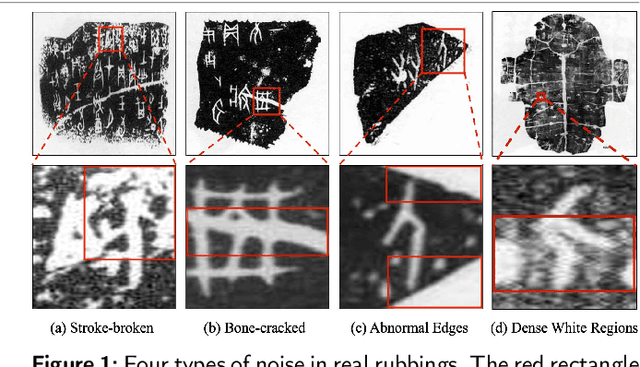
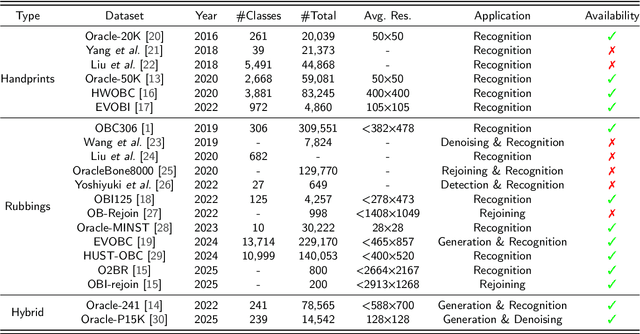
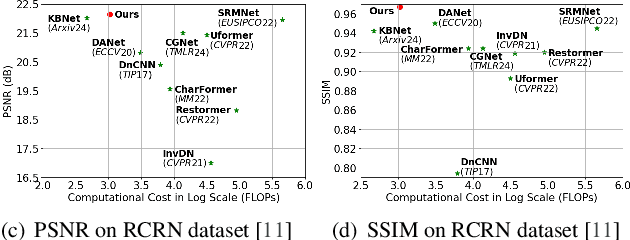
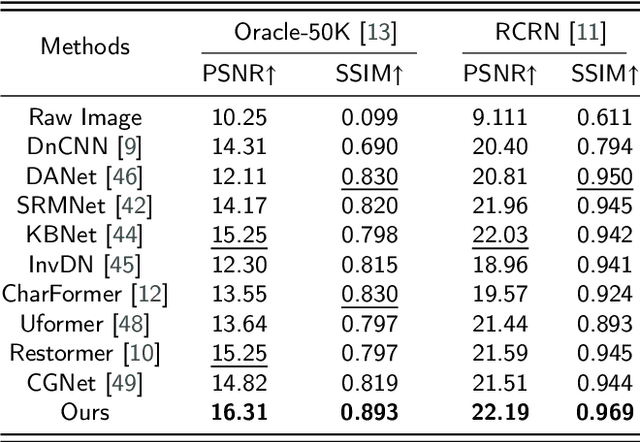
Abstract:Oracle bone inscriptions (OBIs) are the earliest known form of Chinese characters and serve as a valuable resource for research in anthropology and archaeology. However, most excavated fragments are severely degraded due to thousands of years of natural weathering, corrosion, and man-made destruction, making automatic OBI recognition extremely challenging. Previous methods either focus on pixel-level information or utilize vanilla transformers for glyph-based OBI denoising, which leads to tremendous computational overhead. Therefore, this paper proposes a fast attentive denoising framework for oracle bone inscriptions, i.e., OBIFormer. It leverages channel-wise self-attention, glyph extraction, and selective kernel feature fusion to reconstruct denoised images precisely while being computationally efficient. Our OBIFormer achieves state-of-the-art denoising performance for PSNR and SSIM metrics on synthetic and original OBI datasets. Furthermore, comprehensive experiments on a real oracle dataset demonstrate the great potential of our OBIFormer in assisting automatic OBI recognition. The code will be made available at https://github.com/LJHolyGround/OBIFormer.
Mitigating Long-tail Distribution in Oracle Bone Inscriptions: Dataset, Model, and Benchmark
Apr 16, 2025Abstract:The oracle bone inscription (OBI) recognition plays a significant role in understanding the history and culture of ancient China. However, the existing OBI datasets suffer from a long-tail distribution problem, leading to biased performance of OBI recognition models across majority and minority classes. With recent advancements in generative models, OBI synthesis-based data augmentation has become a promising avenue to expand the sample size of minority classes. Unfortunately, current OBI datasets lack large-scale structure-aligned image pairs for generative model training. To address these problems, we first present the Oracle-P15K, a structure-aligned OBI dataset for OBI generation and denoising, consisting of 14,542 images infused with domain knowledge from OBI experts. Second, we propose a diffusion model-based pseudo OBI generator, called OBIDiff, to achieve realistic and controllable OBI generation. Given a clean glyph image and a target rubbing-style image, it can effectively transfer the noise style of the original rubbing to the glyph image. Extensive experiments on OBI downstream tasks and user preference studies show the effectiveness of the proposed Oracle-P15K dataset and demonstrate that OBIDiff can accurately preserve inherent glyph structures while transferring authentic rubbing styles effectively.
SpecEE: Accelerating Large Language Model Inference with Speculative Early Exiting
Apr 11, 2025Abstract:Early exiting has recently emerged as a promising technique for accelerating large language models (LLMs) by effectively reducing the hardware computation and memory access. In this paper, we present SpecEE, a fast LLM inference engine with speculative early exiting. (1) At the algorithm level, we propose the speculation-based lightweight predictor design by exploiting the probabilistic correlation between the speculative tokens and the correct results and high parallelism of GPUs. (2) At the system level, we point out that not all layers need a predictor and design the two-level heuristic predictor scheduling engine based on skewed distribution and contextual similarity. (3) At the mapping level, we point out that different decoding methods share the same essential characteristics, and propose the context-aware merged mapping for predictor with efficient GPU implementations to support speculative decoding, and form a framework for various existing orthogonal acceleration techniques (e.g., quantization and sparse activation) on cloud and personal computer (PC) scenarios, successfully pushing the Pareto frontier of accuracy and speedup. It is worth noting that SpecEE can be applied to any LLM by negligible training overhead in advance without affecting the model original parameters. Extensive experiments show that SpecEE achieves 2.25x and 2.43x speedup with Llama2-7B on cloud and PC scenarios respectively.
SoftmAP: Software-Hardware Co-design for Integer-Only Softmax on Associative Processors
Nov 26, 2024Abstract:Recent research efforts focus on reducing the computational and memory overheads of Large Language Models (LLMs) to make them feasible on resource-constrained devices. Despite advancements in compression techniques, non-linear operators like Softmax and Layernorm remain bottlenecks due to their sensitivity to quantization. We propose SoftmAP, a software-hardware co-design methodology that implements an integer-only low-precision Softmax using In-Memory Compute (IMC) hardware. Our method achieves up to three orders of magnitude improvement in the energy-delay product compared to A100 and RTX3090 GPUs, making LLMs more deployable without compromising performance.
Large Language Model Inference Acceleration: A Comprehensive Hardware Perspective
Oct 06, 2024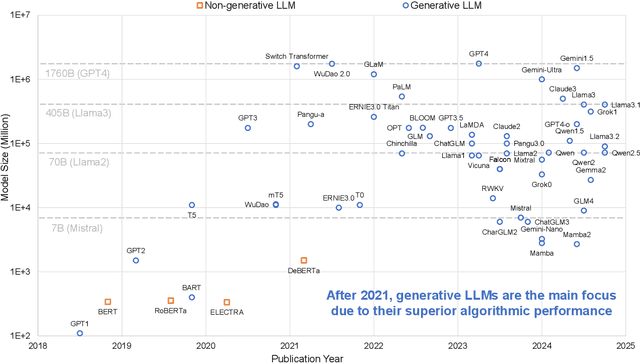

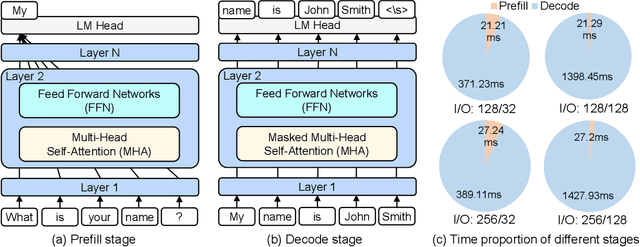
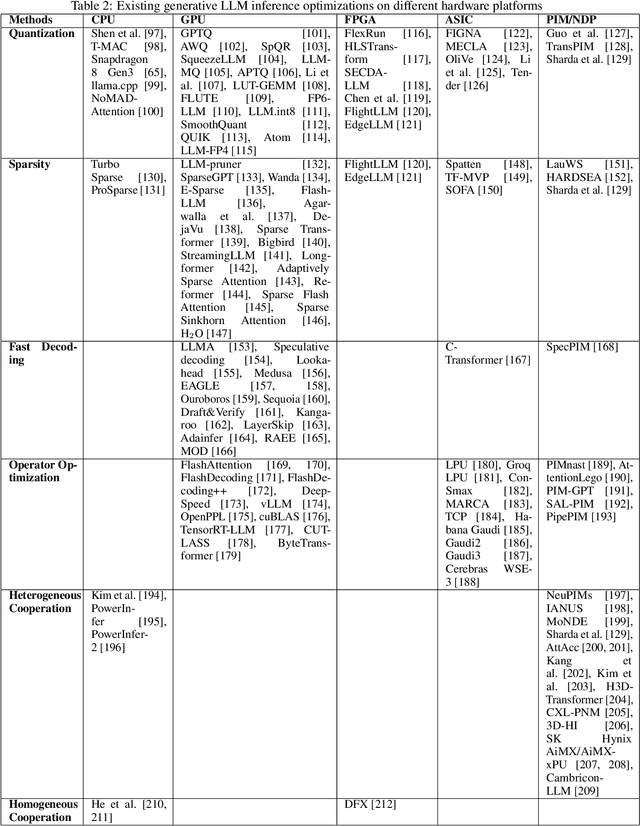
Abstract:Large Language Models (LLMs) have demonstrated remarkable capabilities across various fields, from natural language understanding to text generation. Compared to non-generative LLMs like BERT and DeBERTa, generative LLMs like GPT series and Llama series are currently the main focus due to their superior algorithmic performance. The advancements in generative LLMs are closely intertwined with the development of hardware capabilities. Various hardware platforms exhibit distinct hardware characteristics, which can help improve LLM inference performance. Therefore, this paper comprehensively surveys efficient generative LLM inference on different hardware platforms. First, we provide an overview of the algorithm architecture of mainstream generative LLMs and delve into the inference process. Then, we summarize different optimization methods for different platforms such as CPU, GPU, FPGA, ASIC, and PIM/NDP, and provide inference results for generative LLMs. Furthermore, we perform a qualitative and quantitative comparison of inference performance with batch sizes 1 and 8 on different hardware platforms by considering hardware power consumption, absolute inference speed (tokens/s), and energy efficiency (tokens/J). We compare the performance of the same optimization methods across different hardware platforms, the performance across different hardware platforms, and the performance of different methods on the same hardware platform. This provides a systematic and comprehensive summary of existing inference acceleration work by integrating software optimization methods and hardware platforms, which can point to the future trends and potential developments of generative LLMs and hardware technology for edge-side scenarios.
MARCA: Mamba Accelerator with ReConfigurable Architecture
Sep 16, 2024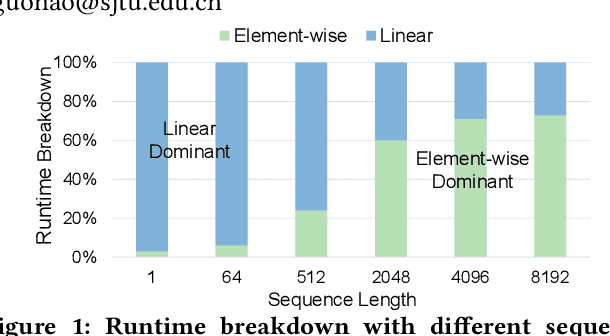


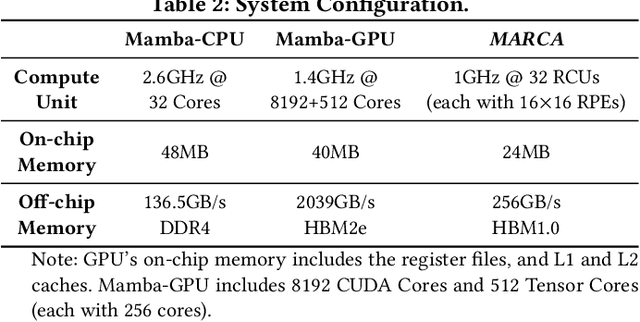
Abstract:We propose a Mamba accelerator with reconfigurable architecture, MARCA.We propose three novel approaches in this paper. (1) Reduction alternative PE array architecture for both linear and element-wise operations. For linear operations, the reduction tree connected to PE arrays is enabled and executes the reduction operation. For element-wise operations, the reduction tree is disabled and the output bypasses. (2) Reusable nonlinear function unit based on the reconfigurable PE. We decompose the exponential function into element-wise operations and a shift operation by a fast biased exponential algorithm, and the activation function (SiLU) into a range detection and element-wise operations by a piecewise approximation algorithm. Thus, the reconfigurable PEs are reused to execute nonlinear functions with negligible accuracy loss.(3) Intra-operation and inter-operation buffer management strategy. We propose intra-operation buffer management strategy to maximize input data sharing for linear operations within operations, and inter-operation strategy for element-wise operations between operations. We conduct extensive experiments on Mamba model families with different sizes.MARCA achieves up to 463.22$\times$/11.66$\times$ speedup and up to 9761.42$\times$/242.52$\times$ energy efficiency compared to Intel Xeon 8358P CPU and NVIDIA Tesla A100 GPU implementations, respectively.
Visual-Text Cross Alignment: Refining the Similarity Score in Vision-Language Models
Jun 05, 2024Abstract:It has recently been discovered that using a pre-trained vision-language model (VLM), e.g., CLIP, to align a whole query image with several finer text descriptions generated by a large language model can significantly enhance zero-shot performance. However, in this paper, we empirically find that the finer descriptions tend to align more effectively with local areas of the query image rather than the whole image, and then we theoretically validate this finding. Thus, we present a method called weighted visual-text cross alignment (WCA). This method begins with a localized visual prompting technique, designed to identify local visual areas within the query image. The local visual areas are then cross-aligned with the finer descriptions by creating a similarity matrix using the pre-trained VLM. To determine how well a query image aligns with each category, we develop a score function based on the weighted similarities in this matrix. Extensive experiments demonstrate that our method significantly improves zero-shot performance across various datasets, achieving results that are even comparable to few-shot learning methods.
Temporal-Aware Deep Reinforcement Learning for Energy Storage Bidding in Energy and Contingency Reserve Markets
Feb 29, 2024
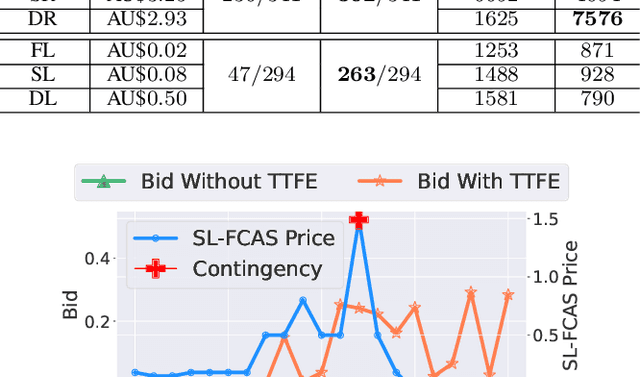
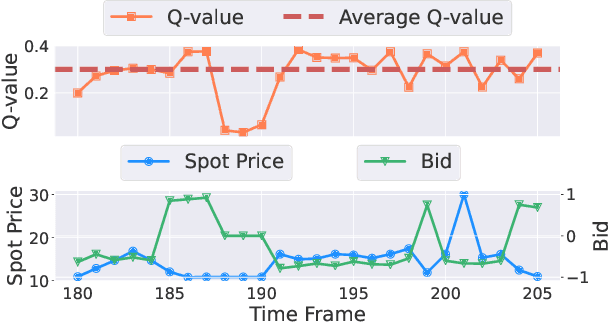
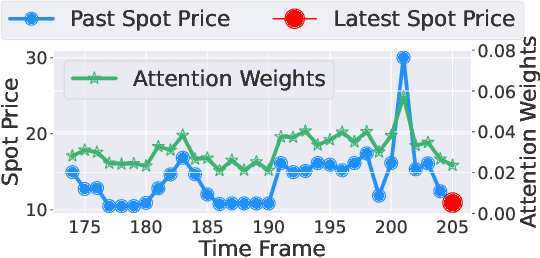
Abstract:The battery energy storage system (BESS) has immense potential for enhancing grid reliability and security through its participation in the electricity market. BESS often seeks various revenue streams by taking part in multiple markets to unlock its full potential, but effective algorithms for joint-market participation under price uncertainties are insufficiently explored in the existing research. To bridge this gap, we develop a novel BESS joint bidding strategy that utilizes deep reinforcement learning (DRL) to bid in the spot and contingency frequency control ancillary services (FCAS) markets. Our approach leverages a transformer-based temporal feature extractor to effectively respond to price fluctuations in seven markets simultaneously and helps DRL learn the best BESS bidding strategy in joint-market participation. Additionally, unlike conventional "black-box" DRL model, our approach is more interpretable and provides valuable insights into the temporal bidding behavior of BESS in the dynamic electricity market. We validate our method using realistic market prices from the Australian National Electricity Market. The results show that our strategy outperforms benchmarks, including both optimization-based and other DRL-based strategies, by substantial margins. Our findings further suggest that effective temporal-aware bidding can significantly increase profits in the spot and contingency FCAS markets compared to individual market participation.
* 15 pages
Attentive Convolutional Deep Reinforcement Learning for Optimizing Solar-Storage Systems in Real-Time Electricity Markets
Jan 29, 2024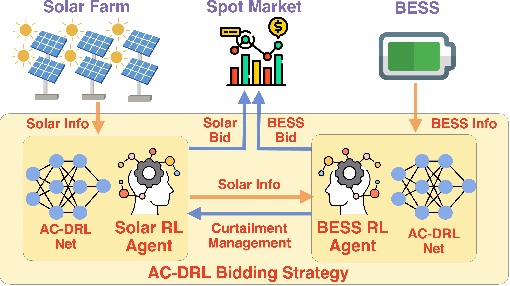

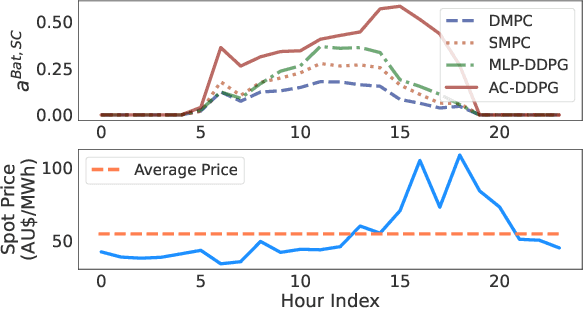
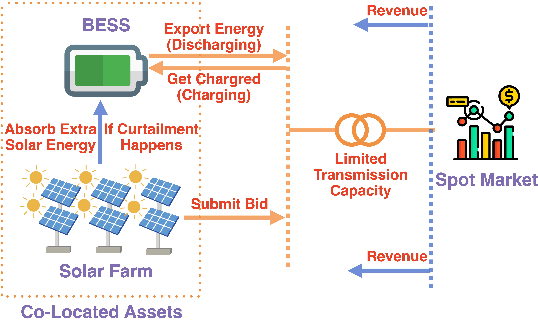
Abstract:This paper studies the synergy of solar-battery energy storage system (BESS) and develops a viable strategy for the BESS to unlock its economic potential by serving as a backup to reduce solar curtailments while also participating in the electricity market. We model the real-time bidding of the solar-battery system as two Markov decision processes for the solar farm and the BESS, respectively. We develop a novel deep reinforcement learning (DRL) algorithm to solve the problem by leveraging attention mechanism (AC) and multi-grained feature convolution to process DRL input for better bidding decisions. Simulation results demonstrate that our AC-DRL outperforms two optimization-based and one DRL-based benchmarks by generating 23%, 20%, and 11% higher revenue, as well as improving curtailment responses. The excess solar generation can effectively charge the BESS to bid in the market, significantly reducing solar curtailments by 76% and creating synergy for the solar-battery system to be more viable.
 Add to Chrome
Add to Chrome Add to Firefox
Add to Firefox Add to Edge
Add to Edge